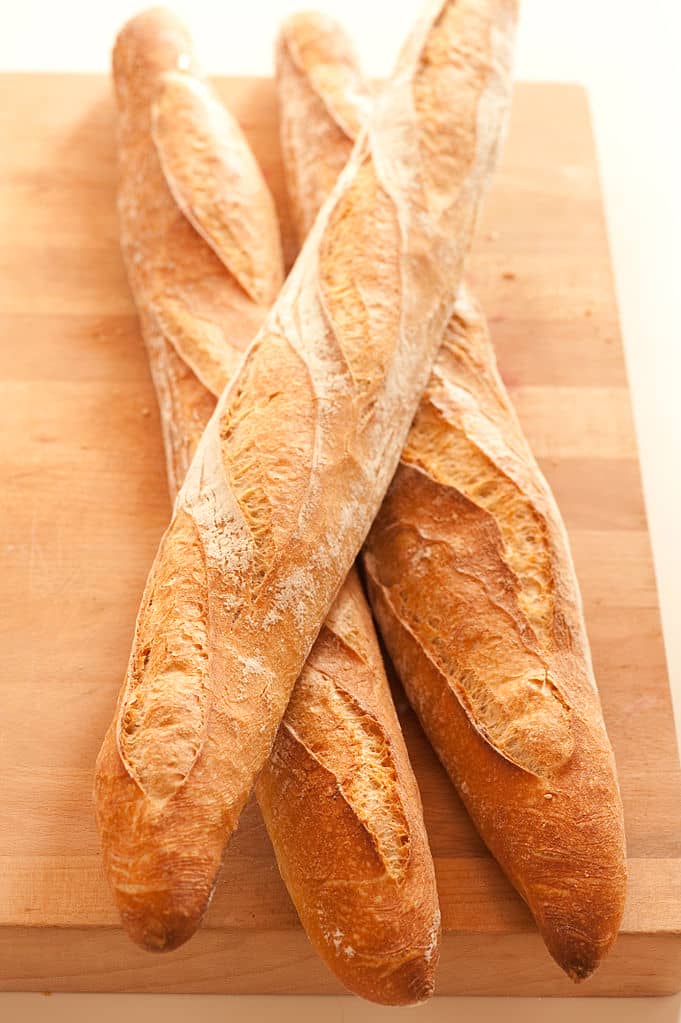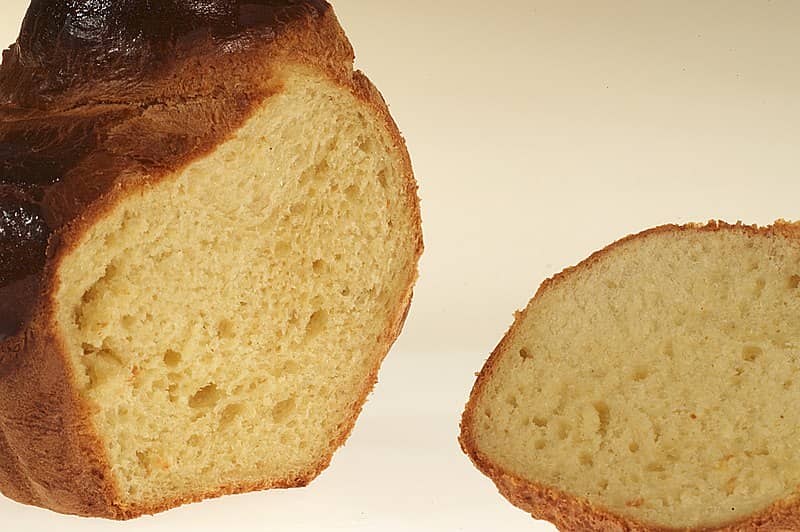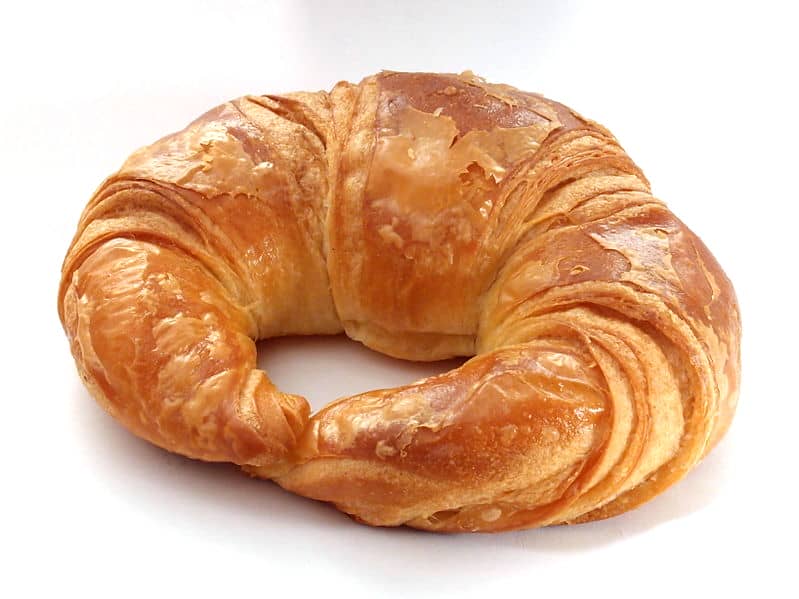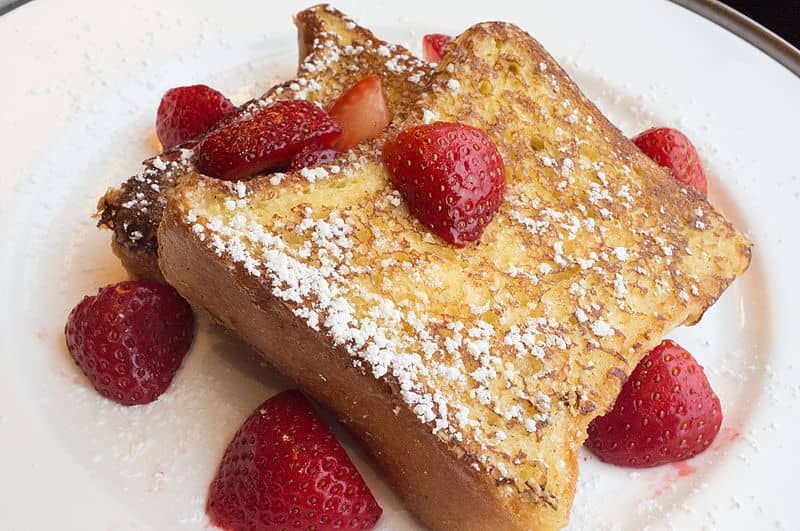Are you looking for typical French breakfasts?
Breakfasts in France are surprisingly basic, considering that the country takes pride in its excellent cuisine. It is also not regarded as the most essential meal of the day, as it is in other countries. Instead, the French regard lunch or dinner to be their “big meal.”
While breakfast in many countries includes savory items such as cheese, eggs, or bacon, breakfast in France is typically sugary and carb-heavy.
The French also do not frequently have breakfast. They simply run out the door with a cup of coffee and some bread or pastry, deferring a more substantial meal until lunchtime.
French breakfast differs by region, so not everyone eats the same thing.
Things you'll find in this article
11 Traditional French Breakfasts

However, the following are the usual breakfast fare you’ll see in homes, cafes, and restaurants:
1. Baguette

A typical, and popular French breakfast, the baguette is a long, thin bread prepared from basic lean dough that is prescribed by French legislation known as Le Décret Pain (The Bread Decree). The length and crispness of the crust distinguish the baguette from other French bread.
Unlike in other countries, the French do not stuff their baguettes with a variety of fillings. Instead, it’s usually served with a dollop of butter and possibly some jam. Baguettes are usually enjoyed in a cafe or on the go as it is best eaten fresh.
There’s also an interesting French breakfast tradition of dipping buttered baguettes in hot coffee or hot chocolate which seems strange but a must-try when in France.
2. Brasillé
A uniquely French breakfast treat, the Brasillé is a flaky, buttery puff pastry filled with gently salted butter, sugar, and eggs.
Puff pastry is rolled out, greased, and molded into an oval shape before being brushed with beaten eggs, then sprinkled with sugar, then baked until the top is puffed and golden.
The term Brasillé comes from the French word brasier, which means “a pan of hot coals or embers,” and refers to the way of baking the pastry in a hot coal oven, which resulted in a somewhat charred top.
This French specialty was originally made with plain bread dough and lard, but Emilie Roussel, a French baker, re-invented it by substituting butter for lard and adding sugar to the mix.
3. Brioche

Another type of bread that you’ll see at French breakfasts is brioche. While brioche is created similarly to other bread, the proportions of its ingredients are different.
Brioche is made with additional eggs and butter, which results in a richer sweeter bread that’s a favorite breakfast treat among the French.
Despite significant discussion concerning the origins of the term “brioche”, it is now commonly recognized that it is derived from the Old French verb “brier.” It’s a “Norman dialectical version of broyer,” which means “to work the dough with a broye or brie (a type of wooden roller for kneading).”
It is now one of the popular breakfast foods in France, and a must-try if you ever step inside a boulangerie.
4. Canistrelli

Canistrelli, also known as cuggioles, cuggiulelles or cujuelles, are sweet, dry, and brittle biscuits. The canistrellis are blessed during a religious rite that takes place in Calvi, the capital of Balagne, during Holy Week, and are thought to have a medieval origin.
These classic shortbread cookies from Corsica are made with flour, sugar, white wine, and flavorings like anise or lemon zest. Because Canistrelli is double-baked, they are extremely crispy and have a long shelf life.
Canistrelli is typically eaten for breakfast and is normally served with hot beverages, but they can make a great sweet snack when served with white wine.
5. Croque Madame

Who can say no to delicious ham and cream cheese sandwiched between two slices of toasted bread? The French have a unique twist to this breakfast sandwich, called a croque madame.
A croque madame is a hot sandwich that consists of ham, cheese, and an egg. It is often served as a breakfast or a quick snack and began in French cafés and bars. The name is derived from the words croque (“crunchy bite”) and madame (“miss” in French.
In the early 1900s, this sandwich was first seen on a menu in a Paris café.
Add some artisanal mustard to kick up the flavor. The tart tang adds just the right amount of zing to an already delicious sandwich.
6. Croissant

The croissant, the most well-known of the viennoiseries (Viennese flaky buns), appears to have descended from the Austrian kipferl.
Legend has it that a Viennese baker relocated to Paris and served kipferl to his bakery’s patrons. Discerning Parisians fell in love with it, embraced it, made important changes to it, and transformed it into the croissant we know today.
Unfortunately, there is no evidence to back up these and other claims about the croissant’s origins.
However, it doesn’t matter where it came from; what matters is that we have it now. Here are some of the croissants that you’ll often see in cafes and boulangeries:
- plain croissant, or croissant ordinaire: they aren’t prepared with butter, and lack that rounded taste. These are also dry and flaky (these are becoming rarer).
- croissant au beurre: For those who can consume butter, the buttered croissant is the favored; it is baked with creamy butter, and you’ll need to wipe your hands clean after eating one.
- croissant aux amandes: This is a very delicious treat that is normally filled with almond cream and topped with toasted shaved almonds and powdered sugar.
7. Gibassier

Gibassier is a pastry made from flour, sugar, eggs, butter, and olive oil, one of the traditional breakfast breads in France. Orange peel, orange-flavored water, and anise seed are frequently added to the dough to give it a distinctive flavor.
The pastry is typically served for breakfast or snack, and it is customary to eat a piece of warm gibassier with a honey butter dip.
Gibassier is thought to have been from the Provence village of Lourmarin. The founder of the San Francisco Baking Institute, Michel Suas, popularized the pastry in the 2000s, and the pie is now popular even outside of France.
8. Oeufs cocotte
Oeufs cocotte (eggs in pots) is a simple and delicate way to serve eggs for breakfast. Both the procedure of baking individual eggs and the little, spherical baking dishes with handles on the sides are known as cocotte.
The eggs are placed in greased pots, ramekins, or cocottes, with flavorings above or below them, and then baked in a hot water bath in the oven until the whites are set but the yolks are still runny.
Bacon, fresh herbs, cheese, pesto, and cream are some of the usual toppings. Oeufs cocotte is also an excellent dish to serve to visitors because it is visually appealing, flavorful, and good at any time of the day.
9. Pain au Chocolat

The pain au chocolat (chocolate bread) has become popular in many parts of the world, however, it will never be as excellent outside of France.
In France, the pastry is known as a chocolatine, but in other areas of the world, it is known as a chocolate croissant.
However, pain au chocolat, is not the same as a croissant, and confusing the two does neither dish credit.
In France, a pain au chocolat is more of a once-in-a-while morning item than a daily breakfast one. After all, the pastries aren’t exactly nutritious.
10. Pain Perdu

Pain perdu is a basic French dish made from old, stale bread that is considered an early version of the famed breakfast fare known as french toast. This dish’s name, which translates as “lost bread” or “waste bread” in French, suggests using stale bread.
To prepare pain perdu, stale bread slices with their crusts removed are soaked in an egg-and-milk combination before being fried until attractively browned and crispy in melted butter. This recipe is said to be from an old English cookbook from around 1430 which contained a recipe for a dish called payn perdu.
11. Tartine
There is no exact translation for ‘tartine’; it can refer to toast, although it isn’t always made with the square, sliced bread that is commonly used in other countries. It’s more akin to an open sandwich, which consists of a slice of bread or toast topped with one or more food items.
It usually refers to a horizontally split half or quarter baguette with butter and jam (or jelly). You can also “dip” your tartine into your café au lait for breakfast if there are no toppings in it. The baguette can be grilled, although it isn’t required.

Hi, I’m Christine – a full-time traveler and career woman. Although I’m from the Philippines, my location independent career took me to over 40 countries and lived in 4 continents in the last 10 years, including France. A self-proclaimed Francophile, I love everything France.
